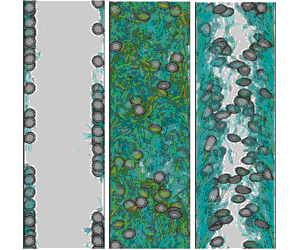Crossref Citations
This article has been cited by the following publications. This list is generated based on data provided by
Crossref.
du Cluzeau, A.
Bois, G.
and
Toutant, A.
2020.
Modelling of the laminar dispersion force in bubbly flows from direct numerical simulations.
Physics of Fluids,
Vol. 32,
Issue. 1,
Fox, Rodney O.
Laurent, Frédérique
and
Vié, Aymeric
2020.
A hyperbolic two-fluid model for compressible flows with arbitrary material-density ratios.
Journal of Fluid Mechanics,
Vol. 903,
Issue. ,
Lee, Jubeom
and
Park, Hyungmin
2020.
Bubble dynamics and bubble-induced agitation in the homogeneous bubble-swarm past a circular cylinder at small to moderate void fractions.
Physical Review Fluids,
Vol. 5,
Issue. 5,
Saikali, E.
Rodio, M.G.
Bois, G.
Bieder, U.
Leterrier, N.
Bertrand, M.
and
Dolias, Y.
2020.
Validation of the hydrodynamics in a turbulent un-baffled stirred tank: A necessity for vortex-reactor precipitation studies.
Chemical Engineering Science,
Vol. 214,
Issue. ,
p.
115426.
Maeda, Kazuki
Date, Masanobu
Sugiyama, Kazuyasu
Takagi, Shu
and
Matsumoto, Yoichiro
2021.
Viscid–inviscid interactions of pairwise bubbles in a turbulent channel flow and their implications for bubble clustering.
Journal of Fluid Mechanics,
Vol. 919,
Issue. ,
Le Roy De Bonneville, F.
Zamansky, R.
Risso, F.
Boulin, A.
and
Haquet, J.-F.
2021.
Numerical simulations of the agitation generated by coarse-grained bubbles moving at large Reynolds number.
Journal of Fluid Mechanics,
Vol. 926,
Issue. ,
Bois, G.
2021.
Derivation of a macroscopic mixture model for two-phase turbulent flows.
International Journal of Heat and Mass Transfer,
Vol. 178,
Issue. ,
p.
121500.
Saikali, E.
Bois, G.
Rodio, M.G.
Bieder, U.
Burlot, A.
and
Bertrand, M.
2021.
Validation of the hydrodynamics in a turbulent un-baffled vortex reactor at two different stirring Reynolds numbers.
Nuclear Engineering and Design,
Vol. 384,
Issue. ,
p.
111450.
Bragg, Andrew D.
Liao, Yixiang
Fröhlich, Jochen
and
Ma, Tian
2021.
Assessment of the validity of a log-law for wall-bounded turbulent bubbly flows.
International Journal of Heat and Fluid Flow,
Vol. 91,
Issue. ,
p.
108857.
Innocenti, Alessio
Jaccod, Alice
Popinet, Stéphane
and
Chibbaro, Sergio
2021.
Direct numerical simulation of bubble-induced turbulence.
Journal of Fluid Mechanics,
Vol. 918,
Issue. ,
du Cluzeau, A.
Bois, G.
Leoni, N.
and
Toutant, A.
2022.
Analysis and modeling of bubble-induced agitation from direct numerical simulation of homogeneous bubbly flows.
Physical Review Fluids,
Vol. 7,
Issue. 4,
Saikali, E.
Bois, G.
Rodio, M.G.
Bieder, U.
Bertrand, M.
Leterrier, N.
and
Dolias, Y.
2022.
Influence of the hydrodynamics and the reaction-rate formulation in modeling infinitely fast irreversible reactions in a turbulent un-baffled chemical reactor.
Chemical Engineering Communications,
Vol. 209,
Issue. 3,
p.
291.
Hamidi, Mohamed Salim
Toutant, Adrien
Mer, Samuel
and
Bataille, Françoise
2023.
Assessment of a coupled VOF-Front-Tracking/DEM method for simulating fluid–particles flows.
International Journal of Multiphase Flow,
Vol. 165,
Issue. ,
p.
104467.
Kuidjo, E.V. Kuidjo
Rodio, M.G.
Abgrall, R.
and
Sagaut, P.
2023.
Comparison of bubbles interaction mechanisms of two-group Interfacial Area Transport Equation model.
International Journal of Multiphase Flow,
Vol. 163,
Issue. ,
p.
104399.
Butaye, Edouard
Toutant, Adrien
and
Mer, Samuel
2023.
Euler–Euler Multi-Scale Simulations of Internal Boiling Flow with Conjugated Heat Transfer.
Applied Mechanics,
Vol. 4,
Issue. 1,
p.
191.
Lu, Min
Yang, Zixuan
and
Deng, Bingqing
2025.
Numerical study of turbulent bubbly upflow: effect of density ratio.
Journal of Fluid Mechanics,
Vol. 1007,
Issue. ,
Zarei, Ahmad
Hooshyari, Liya
Zaboli, Sohrab
Rabiee, Marzie Babaie
Akhavan, Saeed
Seddighi, Sadegh
Mesgarpour, Mehrdad
Wongwises, Somchai
Schlüter, Michael
Ahmadi, Goodarz
Markides, Christos N.
Zhang, Yonghai
Lin, Jianzhong
and
Mahian, Omid
2025.
Bubble injection for heat transfer enhancement: From physics to applications.
Physics Reports,
Vol. 1112,
Issue. ,
p.
1.
Zhang, Lin
Chen, Xinglong
Zhang, Moxi
and
Liu, Nannan
2025.
Mechanism of Vortex Disturbance Generated by Microbubbles Affecting Residual Oil: Microscopic Visual Experiments and Numerical Simulations.
Transport in Porous Media,
Vol. 152,
Issue. 11,
Dupuy, D.
Toutant, A.
du Cluzeau, A.
and
Bois, G.
2025.
Time integration of cut-cell surfaces for geometric conservation, applied to scalar transport with moving interfaces.
Computers & Fluids,
Vol. 295,
Issue. ,
p.
106627.
Procacci, Davide
Arosemena, Arturo A.
Di Giorgio, Simone
and
Solsvik, Jannike
2026.
Turbulence anisotropy modulation in bubble-laden channel flow: A numerical study.
International Journal of Multiphase Flow,
Vol. 195,
Issue. ,
p.
105505.


